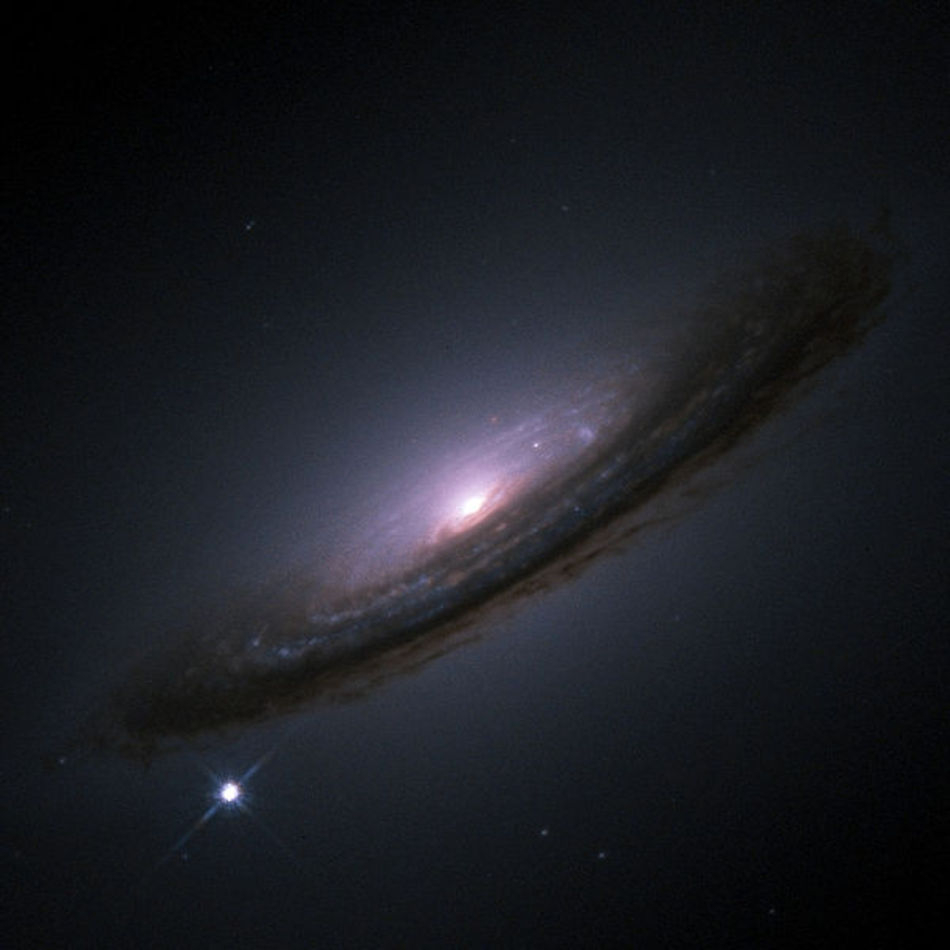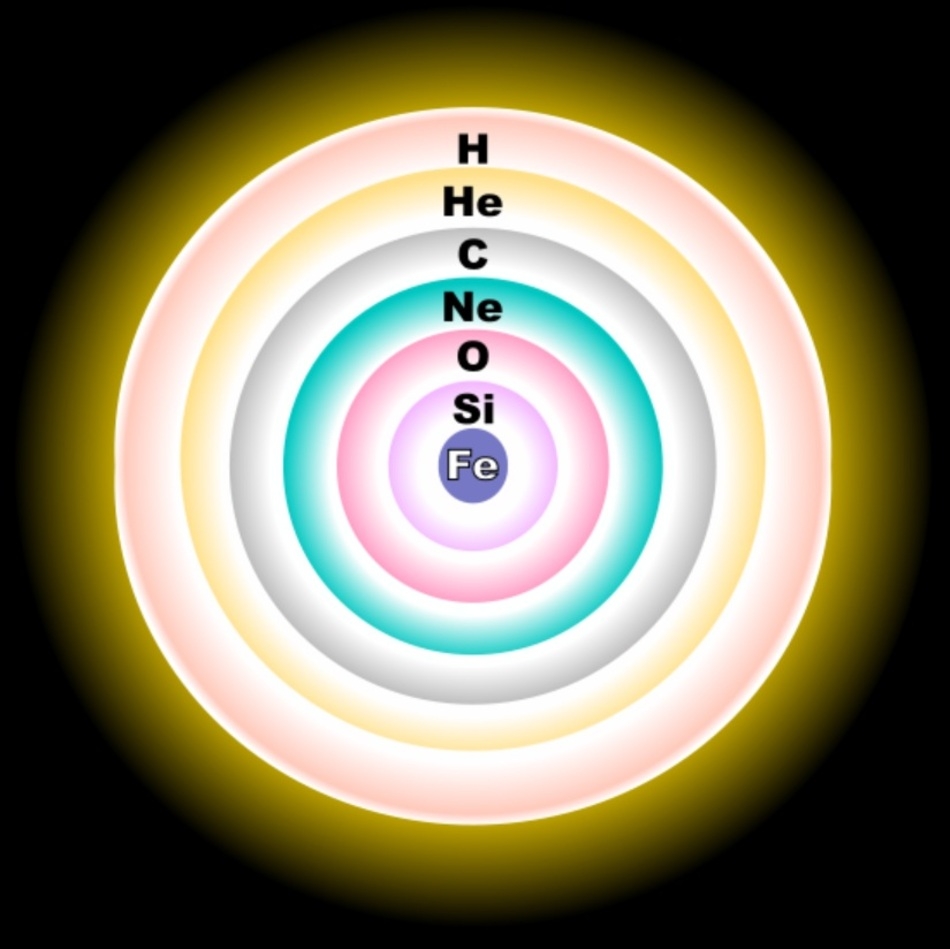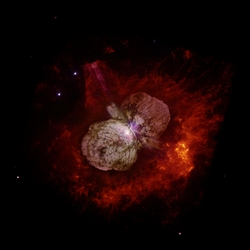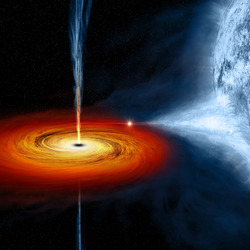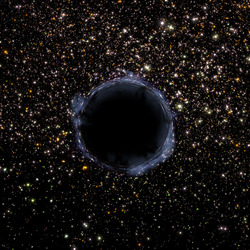
Contents
IntroductionSupernova Type Ia
Supernova Type II
Supernova remnants
Introduction
Supernovae are the most energetic explosions that can occur in the universe. The energy released in a very short time during these explosions can easily reach levels that correspond to the total energy radiated by our sun over its entire lifespan of 10 billion years!
Supernovae play an important role in enriching the interstellar medium with heavier elements, such as oxygen, carbon and nitrogen, fundamental for the formation of new planets and life in general. Furthermore, their shock waves can trigger the collapse of molecular clouds, resulting in the formation of new generations of stars.
There are different types of supernovae which differ in the event triggering the supernova. In general all Type I supernovae have no lines of hydrogen in their spectrum; Type II supernovae contain these lines. Maybe a better way of distinguishing between types of supernovae is to distinguish between runaway nuclear explosion supernovae (only Type Ia) and core collapse supernovae (Types II, Ib and Ic).
The IAU has released a list of supernovae since 1885. Up to supernova 2014L the number and the fraction of the different types of supernovae have been as follows (count by Sun.org):
| Supernova type | Number of supernovae | Percentage |
| Type I | 51 | 0.9% |
| Type Ia | 2912 | 53.2% |
| Type Ib | 107 | 2.0% |
| Type Ib/c | 72 | 1.3% |
| Type Ic | 222 | 4.1% |
| Type II | 2112 | 38.6% |
Type Ia Supernova: a runaway nuclear explosion
This type of supernova is caused by a white dwarf. A white dwarf is the remnant of a sun-like star at the end of its life, a body of about 1 solar mass, mainly composed of carbon and oxygen. The matter is compressed into an earth-sized object with a diameter of between 11000 and 28000 km. The density of a white dwarf is roughly one million time greater than that of the sun, about 1000 kg/cm3 - you can compare this number to an average density of 3 gram/cm3 for the earth's crust or a typical rock. The mass of a white dwarf cannot exceed a certain limit of about 1.4 solar masses (the so-called Chandrasekhar limit); white dwarfs with higher masses cannot support the enormous pressure of their own weight anymore. How can a white dwarf reach this Chandrasekhar limit if its initial mass is lower than 1.4 solar masses? There are two ways:- A companion star loses mass which will be accumulated on the surface of the white dwarf. Remember that about half of the total stars don't live alone like our sun does, but they orbit around each other, mostly in groups of 2 (binary stars), but sometimes even in groups of 3 or 4 stars. When a companion star has reached the end of its life and begins to heat up in the core, the star's outer layers expand and get closer to the white dwarf. At a certain point the gravity of the white dwarf wins and it will start accreting material from the companion star.
- The second option to exceed the Chandrasekhar limit is a merger or collision of two white dwarfs with a combined mass above 1.4 solar masses. Again, this can only happen in binary star systems when both stars have become a white dwarf at the end of their lives.
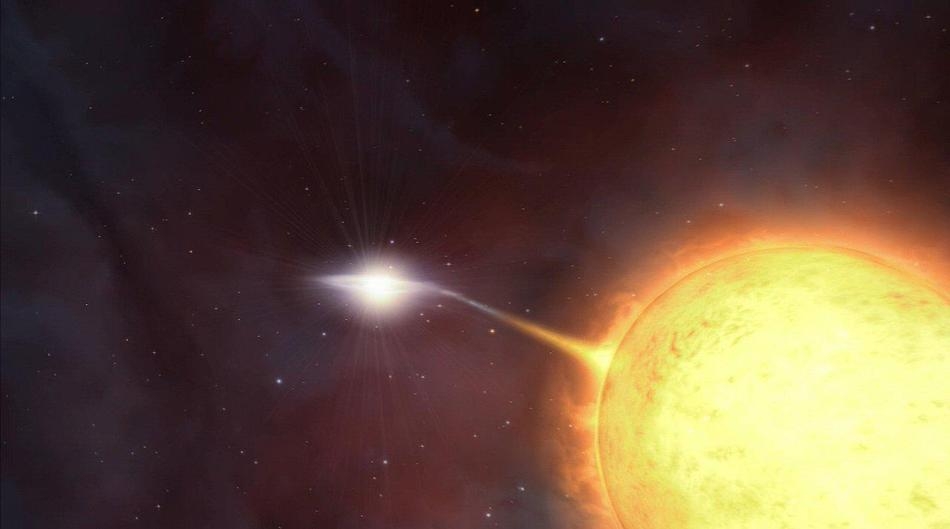 Mass transfer from a companion star to a white dwarf causes a Type Ia supernova. Credit: ESO, M. Kornmesser
Mass transfer from a companion star to a white dwarf causes a Type Ia supernova. Credit: ESO, M. KornmesserWhen a white dwarf accumulates matter - in one way or the other - the temperature in the core rises due to compressional heating. Finally, when it approaches the Chandrasekhar limit of 1.4 solar masses, the temperature reaches the ignition temperature for carbon fusion. Remember, carbon is a main component of the white dwarf. And that's a serious problem for the star. Normal stars during their lifetime react to increasing temperatures in their core by slightly expanding (it's a similar effect to when a gas expands if it gets hotter and compresses as it gets cooler). The expansion of the core decreases the temperature and pressure in the core, leading to a lower fusion rate. This mechanism causes a long-term equilibrium so that a star can have a stable fusion rate over billions of years. But white dwarfs are not composed of normal matter. Due to their high pressure, the matter is in a state called degeneracy. And degeneracy pressure does not depend on temperature like in normal matter. This is a quantum mechanics effect and like most of these quantum effects is not comprehensible for our human brains, but it's still a matter of fact. So when the first carbon fusion in the core of the white dwarf starts, the temperature rises but the pressure does not rise and the star cannot regulate the fusion rate any more. Since the fusion rate is proportional to the fourth power of temperature, a 20% increase in temperature more than doubles the fusion rate; this is a fatal runaway nuclear fusion which leads to the burning of a substantial part of the carbon and oxygen within seconds after the first ignition. The temperature rises to billions of degrees, more than enough energy to rip apart the whole white dwarf, releasing shock waves with matter flying apart at 5000 to 20000 km/s (6% the speed of light) and causing an increase of luminosity of the white dwarf to about 5 billion times that of the sun. Within around 60 days the luminosity has already dropped to 10% of its peak luminosity and the drop continues until it becomes zero within the next 10000 years.
Supernova of Type Ia play an important role in measuring the distances in the universe since they more or less always have the same absolute luminosity (these types of objects are called standard candles). Since luminosity drops with the square of the distance we can figure out the distance by simply figuring out that it's a Type Ia supernova and measuring the luminosity of the event here on earth. This way we can estimate quite well the distance of the galaxy in which the supernova has occurred.
Type Ib, Ic and Type II Supernovae
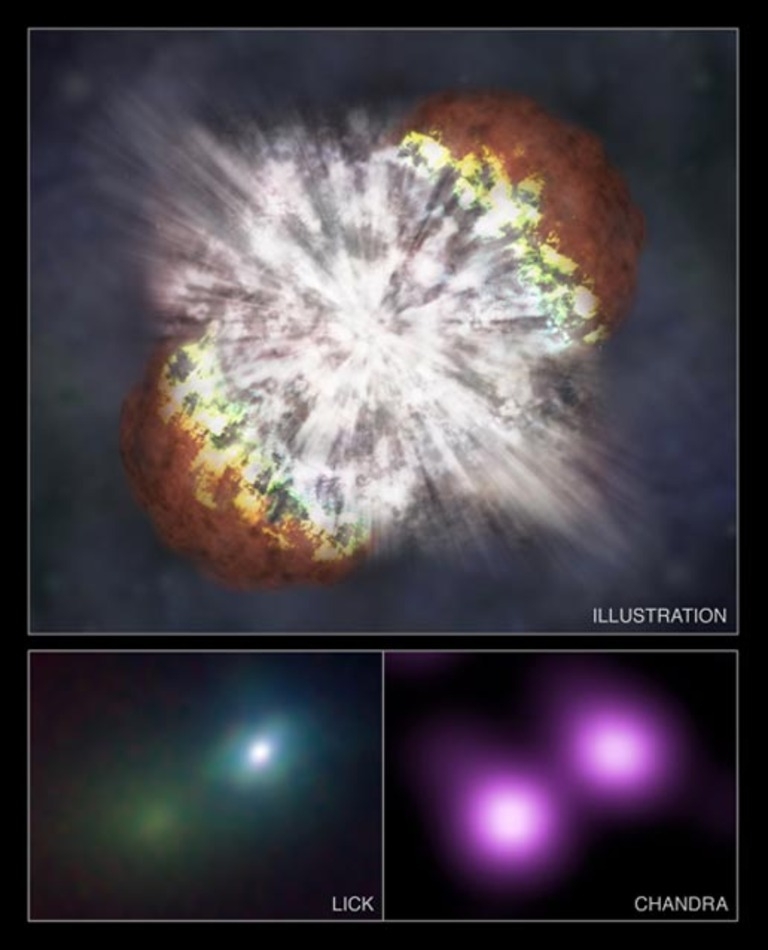
All types of supernovae except Type Ia are caused by the core collapse of a massive star. The main difference between Type II and Type Ib is that the stars of Type Ib supernovae have lost their outer envelope of hydrogen before the final explosion happens (no absorption lines of hydrogen is detected); and the parent star of a Type Ic supernova has also lost most of the helium in its envelope. You can identify this by analysing the absorption lines in the spectra of the supernovae. But the underlying process for all these supernovae is identical: a core collapse.
Core collapse happens when at a certain point in time the core of the star is no longer able to maintain sufficient back-pressure against the gravitational pressure caused by the outer layers of the star. Only stars with masses of 8 solar masses and above have sufficient mass to generate a core collapse supernova. Stars of up to 8 solar masses end their life as white dwarfs - but remember, they still have the "chance" to go to supernovae of Type Ia if they have a companion star.
During the lifetime of a star it releases energy by nuclear fusion of elements. The energy heats up the core and the resulting thermal pressure counters the force of gravity from the outer layers. This hydrostatic equilibrium is maintained throughout most of a star’s life. After all the hydrogen is fused to helium, energy production and, as a consequence, also thermal pressure starts to decrease. Temperatures and pressures are not yet high enough to start fusion of helium to heavier elements - it needs higher temperatures and pressures to fuse helium into heavier elements than it needs to fuse hydrogen into helium. The result is a core compression caused by the force of gravity of the outer layers and consequently an increase in temperature and pressure in the core. Now the temperature and pressure reach the point at which helium fusion can start. The same mechanism repeats when all the helium in the core is exhausted.
The core gets hotter and hotter over time, consequently being able to burn heavier and heavier elements. After all the hydrogen has been fused to helium the star mainly produces carbon, neon, oxygen, silicon and finally iron. The burning of lighter elements still occurs in shells around the core where the pressure and temperature are not high enough to fuse the heaviest elements, but it's still high enough to fuse lighter elements. Now this process cannot continue forever because the fusion of iron does not release energy anymore; it would require energy to cause the fusion of iron to higher elements. That's the point in time where the production of heat and consequently thermal pressure in the core has stopped and from now on the destiny of the star is clearly defined: a core collapse supernova is going to follow soon.
As soon as a core collapse has initiated things go really fast; the core collapses with a tremendous speed (percentage rate of the speed of light) and within a few tenths of a second it shrinks down from earth size to about 20 km in diameter and the temperature increases to billions of K. At first it's just the core that collapses, the outer layers react slower (more on this later).
But why does the pressure of the outer layers finally cause the core to collapse? There are four mechanisms: electron capture, reaching the Chandrasekhar limit, pair-instability or photodisintegration. In summary:
- electron-capture happens in a degenerate core composed mainly of the fusion products oxygen, neon and magnesium. In this case the core of the star has not been completely fused to iron since the star is not massive enough to generate the extremely high temperatures and pressures needed to fuse iron. The O-Ne-Mg core is again supported by degeneracy pressure (in brief, you cannot squeeze two electrons into the same quantum state). Electron capture means that magnesium and/or neon starts capturing these electrons that are necessary to uphold the degeneracy pressure; you can imagine what happens next. The core is no longer able to support the weight of the outer layers and the core begins its collapse, the end product is a neutron star or a black hole. That's the type of supernova that occurs if the progenitor star has a mass of 8 to 10 solar masses.
- reaching the Chandrasekhar limit occurs when a star has fused enough iron so that its core has a mass greater than the Chandrasekhar limit (1.4 solar masses). The degenerated iron is then no longer able to support its own weight, the core collapse begins. The result is again a neutron star or a black hole and the progenitor star has to have a mass of 10 to 90 solar masses or more to trigger this type of core collapse.
- pair-instability means that a very massive star produces so many gamma-rays in its core that part of their energy is drained away into the production of particle/anti-particle pairs. One result is a drop in pressure which initiates core collapse. This drop in pressure causes a runaway thermonuclear reaction which completely rips the star apart without leaving any remnant behind. This only happens with very massive stars of between 140 and 250 solar masses.
- Photodisintegration is a process where the core of the star is large and hot enough to produce a large amount of extremely high energy gamma-rays that can blow the heavy nuclei apart into hydrogen and helium. E.g. a silicon atom with 28 protons and neutrons in its nucleus can be disintegrated into 7 helium atoms. This process leads to a fast cooling of the core; the gravitational pressure rapidly triumphs over thermal pressure and the core completely collapses into a massive black hole. This only happens to extremely massive stars with masses greater than 250 solar masses. The most massive known star with its whopping 265 solar masses will suffer this fate. No material at all can escape in the case of such a core collapse; the star will entirely collapse into the black hole.
When the core collapses, electron degeneracy is completely overcome and cannot help to support the core anymore. Apart from the pair-instability collapse where the runaway nuclear fusion blows away the whole star leaving no remnant, all the other types of collapse lead to a tremendous pressure at which the electrons are forced to combine with protons to form neutrons. The end result is a core with a diameter of a few kilometres that mainly consists of neutrons. It's so dense that one cubic centimetre (1 cm3) has the same mass as all the cars in the USA combined! So, if you always wanted to know what's the smallest piece of junk you can get with a huge scrap metal press if you put all the cars in the USA into this press, now you know! It's just 1 cm3, and technically speaking it has a density of 800 million tons/cm3. The initial temperature of this neutron star is 100 billion K. Almost the entire gravitational energy released from the decay of the core is carried away by a huge storm of neutrinos. For a period of about 10 s following the beginning of core collapse, the energy carried away by this neutrino storm exceeds the total amount of energy emitted by all known stars in the universe. Let's all be thankful that these neutrinos almost do not interact at all with normal matter. The small 1% fraction of energy released as light is still able to shine hundreds of millions times more brightly than our sun does. The complete core collapse from the first beginning up to the formation of the neutron star happens in just a quarter of a second. Will this neutron star finally be able to stop the collapse? We'll look at that in a moment.
Video of an illustration of the Crab Nebula supernova from the year 1054. Credit: ESA/Hubble (M. Kornmesser & L. L. Christensen)
At the same time as the core collapses the outer layers remain unsupported and also start to collapse in gravitational free fall towards the centre of the star. They can reach speeds of up to 23% the speed of light. The inner parts of these outer layers begin their fall first; the outer parts follow continuously as soon as they don't feel the support of the inner parts any more. Now it's definitely a good idea not to remain in the area between the newly formed neutron star and the collapsing outer layers. Why? Millions of earth masses will fall down at relativistic speeds, collide with the neutron star with immense momentum and create "the mother of all shock waves" in the universe. They bounce back and then collide with the parts of the outer layer that fell later. The shock wave propagates from the surface of the neutron star to the upper layers of the star's collapsing atmosphere resulting in 96% of the matter of the outer star being blown away into the interstellar medium with high velocities. During this process all the chemical elements heavier than iron are created in this short time when the shock wave propagates through the atmosphere of the star (r-process). This was at least the theory until the 2020s. Recent research tells us that most atoms heavier than iron are formed in the collision of neutron stars and through flares from magnetars. However, further research is still needed to understand these processes in detail and to learn which of these events is responsible for which proportion of heavy elements.
Considering the enormous masses and speeds involved in this process (many solar masses) you can imagine that a core collapse will not be without consequences. Indeed it has noticeable effects especially on all planets within a radius of about 100 light years! Their atmospheres can be destroyed or damaged or their ozone layer can be depleted.
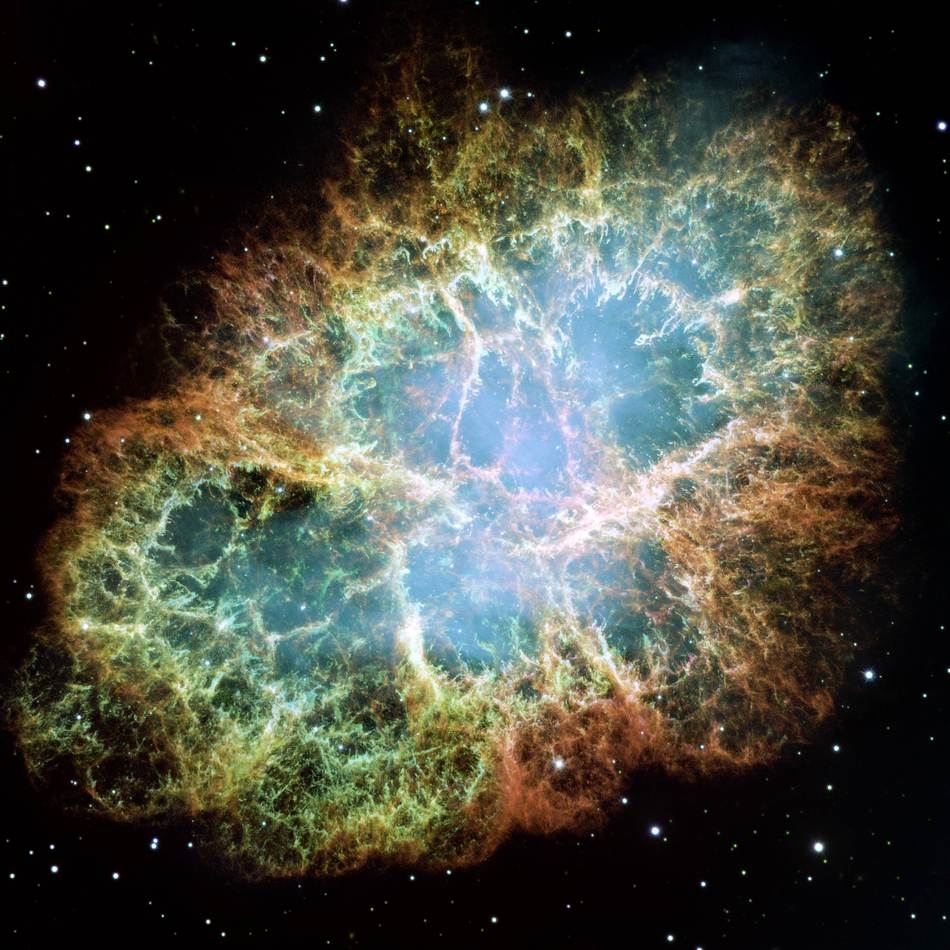 The Crab Nebula. The colours correspond to different elements that were blown away after the explosion: orange is hydrogen, green is sulphur and red is oxygen. Credit: NASA, ESA, J. Hester (Arizona State University)
The Crab Nebula. The colours correspond to different elements that were blown away after the explosion: orange is hydrogen, green is sulphur and red is oxygen. Credit: NASA, ESA, J. Hester (Arizona State University)Finally, let's come back to the question of whether the formation of the ultra-dense neutron star can stop the collapse. For most stars the neutron star stops any further collapse and it is even able to bounce back the biggest part of the remaining mass of the star into space as we have observed above. The neutron star can withstand these enormous pressures due to neutron degeneracy. Neutron degeneracy is similar to electron degeneracy, but since the mass of a neutron is much greater than that of an electron it can support a much higher pressure (you can read the degeneracy article on Sun.org to better understand this state of matter). If the mass of the neutron star is below 3 solar masses, neutron degeneracy can avoid further collapse. But for the most massive stars the neutron star is not the end of the story. The heaviest stars have so much mass that they would create neutron stars of more than 3 solar masses, too much for a neutron star to sustain itself. In these cases the neutron star immediately collapses again and forms the final and most irreversible state any matter can reach: a black hole. That's the definite end of the story for the neutron star and everything surrounding it. There will not even be any observable supernova since matter cannot bounce back from the neutron star; it just falls into the black hole. But as the matter approaches the black hole it can create an accretion disk of matter around the black hole so hot that it emits an enormous amount of gamma rays along the axis of rotation of the former star or now the black hole (yes, a black hole can rotate). This phenomenon is called Gamma Ray Burst (or GRB for short). These jets or beams of gamma rays are concentrated just along the axis of rotation which makes them so strong that in 2008 a GRB nearly 8 billion light years away was still visible to the naked eye. A GRB that would be produced by Eta Carinae, for example, a star with 150 solar masses at a distance of 7500 light years, could still severely damage the earth if the axis of rotation was directly headed towards the earth (which thankfully is not the case). Despite the huge distance we would be able to see a light ten times brighter than the full moon, all unprotected electronic devices and power grids would be destroyed by the electromagnetic impulse and the ozone layer would be partially disintegrated. But again, there is no super massive star close to us that could hit us with a GRB, so we are safe from this danger.
Supernova remnants
A supernova remnant is a more or less regular shell of gas and dust that has been blown away as a result of a supernova explosion. The explosions are so violent that they can accelerate the stellar material to as much as 10% of the speed of light. Strong shock waves emerge ahead of the expanding shell when it hits the surrounding interstellar gas and dust. Temperatures in these areas can reach well above 1 million degrees Kelvin, resulting in strong emissions across the whole spectrum, but especially in X-rays. Over a period of many thousand years (roughly 30000 - 50000 years) the shock wave slows down, mixing the material of the exploding star with the interstellar medium, another way of enriching the interstellar medium with heavy elements like oxygen, nitrogen and carbon.
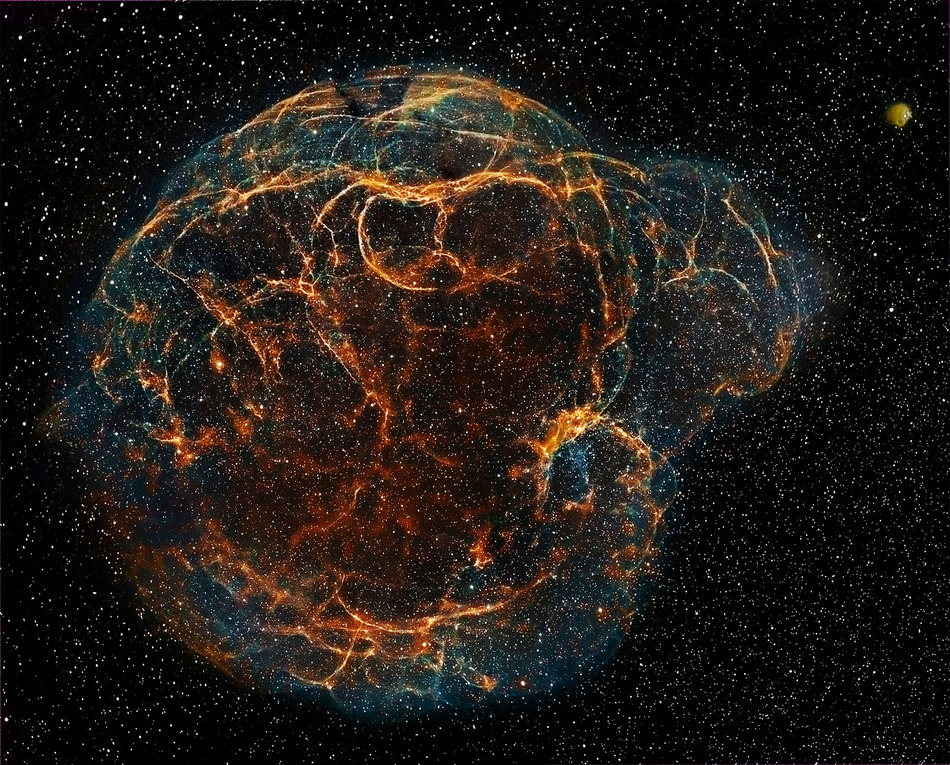 Supernova remnant Simeis 147. 40000 years after the explosion the diameter of the remnant is now 140 light years. Credit: Emil Ivanov
Supernova remnant Simeis 147. 40000 years after the explosion the diameter of the remnant is now 140 light years. Credit: Emil IvanovThe distance that the stellar material travels in this time can be a hundred light years or more. A good example of recent supernova remnant is the Crab Nebula, a 40000 years old remnant is Simeis 147. Other types of nebulae that can be observed are emission nebula and reflection nebula.
